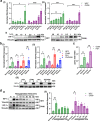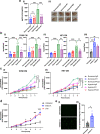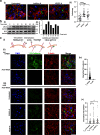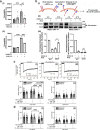Hypoxia-induced inhibin promotes tumor growth and vascular permeability in ovarian cancers
- PMID: 35654828
- PMCID: PMC9163327
- DOI: 10.1038/s42003-022-03495-6
Hypoxia-induced inhibin promotes tumor growth and vascular permeability in ovarian cancers
Abstract
Hypoxia, a driver of tumor growth and metastasis, regulates angiogenic pathways that are targets for vessel normalization and ovarian cancer management. However, toxicities and resistance to anti-angiogenics can limit their use making identification of new targets vital. Inhibin, a heteromeric TGFβ ligand, is a contextual regulator of tumor progression acting as an early tumor suppressor, yet also an established biomarker for ovarian cancers. Here, we find that hypoxia increases inhibin levels in ovarian cancer cell lines, xenograft tumors, and patients. Inhibin is regulated primarily through HIF-1, shifting the balance under hypoxia from activins to inhibins. Hypoxia regulated inhibin promotes tumor growth, endothelial cell invasion and permeability. Targeting inhibin in vivo through knockdown and anti-inhibin strategies robustly reduces permeability in vivo and alters the balance of pro and anti-angiogenic mechanisms resulting in vascular normalization. Mechanistically, inhibin regulates permeability by increasing VE-cadherin internalization via ACVRL1 and CD105, a receptor complex that we find to be stabilized directly by inhibin. Our findings demonstrate direct roles for inhibins in vascular normalization via TGF-β receptors providing new insights into the therapeutic significance of inhibins as a strategy to normalize the tumor vasculature in ovarian cancer.
© 2022. The Author(s).
Conflict of interest statement
The authors declare no competing interest.
Figures







Similar articles
-
Evolving roles of activins and inhibins in ovarian cancer pathophysiology.Am J Physiol Cell Physiol. 2023 Feb 1;324(2):C428-C437. doi: 10.1152/ajpcell.00178.2022. Epub 2023 Jan 9. Am J Physiol Cell Physiol. 2023. PMID: 36622068 Free PMC article. Review.
-
The inhibin/activin signalling pathway in human gonadal and adrenal cancers.Mol Hum Reprod. 2014 Dec;20(12):1223-37. doi: 10.1093/molehr/gau074. Epub 2014 Sep 1. Mol Hum Reprod. 2014. PMID: 25180271
-
Properties of inhibin binding to betaglycan, InhBP/p120 and the activin type II receptors.Mol Cell Endocrinol. 2002 Oct 31;196(1-2):79-93. doi: 10.1016/s0303-7207(02)00227-7. Mol Cell Endocrinol. 2002. PMID: 12385827
-
Inhibin Is a Novel Paracrine Factor for Tumor Angiogenesis and Metastasis.Cancer Res. 2018 Jun 1;78(11):2978-2989. doi: 10.1158/0008-5472.CAN-17-2316. Epub 2018 Mar 13. Cancer Res. 2018. PMID: 29535220 Free PMC article.
-
Mechanisms of inhibin signal transduction.Recent Prog Horm Res. 2001;56:417-50. doi: 10.1210/rp.56.1.417. Recent Prog Horm Res. 2001. PMID: 11237224 Review.
Cited by
-
Evolving roles of activins and inhibins in ovarian cancer pathophysiology.Am J Physiol Cell Physiol. 2023 Feb 1;324(2):C428-C437. doi: 10.1152/ajpcell.00178.2022. Epub 2023 Jan 9. Am J Physiol Cell Physiol. 2023. PMID: 36622068 Free PMC article. Review.
-
TCEB2/HIF1A signaling axis promotes chemoresistance in ovarian cancer cells by enhancing glycolysis and angiogenesis.Eur J Med Res. 2024 Sep 11;29(1):456. doi: 10.1186/s40001-024-02050-9. Eur J Med Res. 2024. PMID: 39261917 Free PMC article.
-
New aspects of TGF-β superfamily signaling in development and disease (2022 FASEB meeting review).Fac Rev. 2022 Dec 15;11:36. doi: 10.12703/r/11-36. eCollection 2022. Fac Rev. 2022. PMID: 36644295 Free PMC article. Review.
-
NRP1 interacts with endoglin and VEGFR2 to modulate VEGF signaling and endothelial cell sprouting.Commun Biol. 2024 Jan 19;7(1):112. doi: 10.1038/s42003-024-05798-2. Commun Biol. 2024. PMID: 38242992 Free PMC article.
-
Engineering of the microenvironment to accelerate vascular regeneration.Trends Mol Med. 2023 Jan;29(1):35-47. doi: 10.1016/j.molmed.2022.10.005. Epub 2022 Nov 9. Trends Mol Med. 2023. PMID: 36371337 Free PMC article. Review.
References
Publication types
MeSH terms
Substances
Grants and funding
LinkOut - more resources
Full Text Sources
Medical

